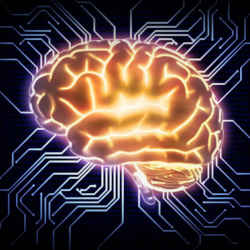
Silicon-based computing has always delivered trade-offs. While these systems perform many tasks that are completely out of reach for human beings, they cannot think and behave like people. As a result, even the most advanced systems cannot do things that are relatively simple for humans.
Biocomputing may change all of this. The field, which draws intelligence from actual brain cells, is advancing rapidly. The ability to place hundreds of thousands, or even millions of stem cells into machines that could deliver human-like cognition, could transform fields as diverse as agriculture, biomedicine, cybersecurity and transportation.
"The dream of intelligence in a dish has been around for about 20 years," says Thomas Hartung, a professor at Johns Hopkins University and the University of Constance in Germany. "We are now reaching a point where it's possible to use brain organoids for certain types of computing tasks."
The ability for biocomputers to interact with sensors and conventional silicon computers could also usher in capabilities that exceed the limitations of either type of device today. Yet biocomputing presents serious ethical concerns, including the possibility the technology could be misused or abused, or at some point collections of cells could achieve sentience.
Silicon Meets Neurons
Biocomputing, once a fantastical and even implausible idea, is now on the fast track to scientific reality. In February, an international group of researchers headed by Hartung presented an academic paper in the Journal Frontiers of Science outlining a path to organoid intelligence and biocomputing.
Thanks to advances in cultivating human stem cell-derived organoids—bioengineered groups of cells—researchers can construct a machine adapted to biologically-based computing. They connect electrodes to a group of DNA and RNA cells, typically held in an environmentally stable container, and then train the cells to focus on tasks using silicon-based reinforcement learning methods.
The potential use-cases for biocomputing systems are remarkably broad—and the technology's ultra-low energy demands are appealing. "Biocomputing could make a major impact in almost every field," says Alysson R. Muotri, a professor in the Departments of Pediatrics and Cellular & Molecular Medicine at the University of California, San Diego, and director of the university's Stem Cell Program.
Among the possible applications for biocomputing: drug design, gene therapy, facial recognition, and smart systems that incorporate human thinking. The cells, which have the ability to self-organize and repair themselves, could lead to new types of software and systems. "Basically, anything that requires human intuition would benefit," Muotri says.
Biocomputing devices also could incorporate brain cells from other animals that display specialized characteristics, whether it's the hearing of a dog or the electrosensitive perception of a shark. This feature could lead to systems better equipped to sniff out diseases and ambient environmental risks, or perhaps to sense things in the dark or behind other objects.
Hartung believes the technology could also aid in optimizing existing silicon-based computing architectures, including neuromorphic computing, and usher in hybrid silicon-bio systems that combine the best elements of each. "These computers could be adept at making intuitive decisions based on incomplete datasets," he explains.
Managing Impulses
Biocomputing is in its infancy. Melbourne, Australia-based Cortical Labs is currently engineering a commercially available kit to develop biocomputing systems. Brett Kagan, chief scientific officer for the firm, says that while the short-term and long-term visions of the technology are fairly clear, the projected rate of progress remains a bit murky.
"There are still a huge number of technical questions, including how to develop the right mix of cells and how to leverage the technology," Kagan says. While doctors and others can collect cells from small blood samples during routine testing—and researchers can turn them into stem cells that can be grown into functioning neurons—determining how to train the cells is difficult. "There are lots of questions about how to shape and structure an environment so that neurons do useful things," he says.
Ethical concerns also enter the picture. It is not inconceivable that human organoids could become conscious or self-aware, Muotri points out. Sentient AI systems could raise questions about personhood and how groups of biocomputing cells are used. As a result, "We may require ways to limit the ability of cells to jump to sentience and how the technology is used," Kagan says.
For now, as Hartung and other researchers continue to poke and probe the space, they are interested in gaining insights from independent bioethicists and others that can help guide the focus of their research and the overall direction of biocomputing technology.
Concludes Hartung: "At some point in the future we will see the emergence of biological computing models. Once these systems overcome a number of technical challenges, we will have the ability to construct entirely new and different types of computers—and even interact with AI in new and sometimes profound ways."
Samuel Greengard is an author and journalist based in West Linn, OR, USA.



Join the Discussion (0)
Become a Member or Sign In to Post a Comment